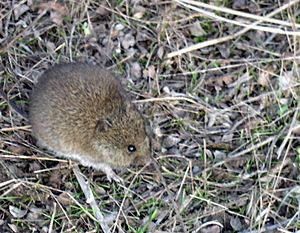Western mouse facts for kids
Quick facts for kids Western mouse |
|
|---|---|
 |
|
| Conservation status | |
| Scientific classification | |
| Genus: |
Pseudomys
|
| Species: |
occidentalis
|
The western mouse, also known as the walyadji, is a small rodent from the mouse family, Muridae. Its scientific name is Pseudomys occidentalis.
These mice used to live in many places across Southwest Australia. Now, they are only found in about ten special areas of bushland. Because of this, they are considered "near threatened" with extinction. Western mice are small and strong. They live in burrows in sandy soil. At night, they come out to look for food nearby.
Contents
What is the Western Mouse?
The western mouse is a type of mouse-like rodent. It was first described in 1951 by a scientist named George Henry Hamilton Tate. He used mouse samples collected in 1930 to study them.
The main sample, called a holotype, was a skin and skull from a young adult mouse. It was found at Tambellup. Tate also looked at another sample, which was a bit larger.
The western mouse belongs to a group of mice called Pseudomys. This group has many different types of mice. The name "walyadji" is sometimes used for this mouse. However, this word does not appear in old records of Noongar language names for animals in the area.
Physical Features of the Western Mouse
The western mouse is about 10 centimeters (4 inches) long. Its tail can be even longer, up to 14 centimeters (5.5 inches). An average western mouse weighs about 34 grams (1.2 ounces).
Its fur is soft and fine. It is dark gray and yellowish-brown, with some black hairs mixed in. The mouse's feet are white.
This mouse has a special nose shape that looks a bit like a bird's beak. Its long tail also helps tell it apart from other mice.
The total length of its head and body is usually between 88 and 110 millimeters. Its tail is longer, from 120 to 140 millimeters.
The back feet of the western mouse are quite long for a mouse in its group, measuring 24 to 28 millimeters. The pads on its feet are also larger than the pads at the very end of its toes. These foot features help scientists tell it apart from other mice, like the Pseudomys albocinereus.
Female western mice have two pairs of teats on their lower belly. Their weight can range from 30 to 55 grams.
How Western Mice Live
Western mice build their homes underground. These homes are called burrows. Each burrow has only one entrance. This entrance leads to a network of tunnels about 20 to 30 centimeters (8 to 12 inches) below the surface.
The main tunnel forms a loop. At one end of this loop, about two to three meters from the entrance, is the nest site. Other loops and tunnels extend from the main tunnel. Up to ten western mice might live together in one burrow system.
Where Western Mice Live
The western mouse used to live across a much larger area in Southwest Australia. It even lived in some dry, inner parts of the country. Now, it is only found in a few places. These include areas near the Ravensthorpe Range, at Fitzgerald River National Park, and some separate groups in the southern Wheatbelt region.
These mice prefer to live in loamy soils. They like areas that have not had fires recently. In fact, they are not found in any place that has burned in the last 30 to 50 years. Their habitat has mature plants, especially the desert quandong Santalum acuminatum and sedge-like plants.
The ground where they live is usually sandy or sandy-clay soil. It often has gravel mixed in. The types of plants found in their remaining homes include Eucalyptus, Acacia, Isopogon, Allocasuarina, and Melaleuca. Their habitat can be very different, from open woodlands to low or tall shrublands, and even dense areas of mallee and heath plants.
After the species was first identified in 1951, only five samples were known. More mice were found when the state museum started surveying mammals in the region in 1971.
Protecting the Western Mouse
In 2016, the western mouse was listed as "near threatened." This means its population is decreasing. The area where it lives is now less than 200 square kilometers (77 square miles).
The groups of western mice are separated from each other. They live in small pieces of their preferred habitat. Scientists believe there are more than 10 such groups. The population has likely dropped by less than 30% over three generations of mice.
Losing their habitat is a big problem for these mice. Also, climate change, caused by humans, is expected to harm the western mouse population even more in the future.
See also
 In Spanish: Pseudomys occidentalis para niños
In Spanish: Pseudomys occidentalis para niños


